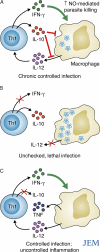Interleukin-10 production by effector T cells: Th1 cells show self control
- PMID: 17296790
- PMCID: PMC2118719
- DOI: 10.1084/jem.20070104
Interleukin-10 production by effector T cells: Th1 cells show self control
Abstract
Interleukin (IL)-10 is a cytokine that modulates both innate and adaptive immunity, primarily by exerting antiinflammatory effects. IL-10 was originally thought to be produced only by T helper (Th)2 cells, but is now known to be made by a variety of cell types. During many infections, CD4(+) T cells produce both interferon (IFN)-gamma, the signature Th1 cytokine, and IL-10. New data now show that the IL-10 produced by effector Th1 cells helps limit the collateral damage caused by exaggerated inflammation. But this control may also limit the effectiveness of the immune response, resulting in a failure to fully eliminate pathogens.
Figures


Comment on
-
Conventional T-bet(+)Foxp3(-) Th1 cells are the major source of host-protective regulatory IL-10 during intracellular protozoan infection.J Exp Med. 2007 Feb 19;204(2):273-83. doi: 10.1084/jem.20062175. Epub 2007 Feb 5. J Exp Med. 2007. PMID: 17283209 Free PMC article.
-
CD4(+)CD25(-)Foxp3(-) Th1 cells are the source of IL-10-mediated immune suppression in chronic cutaneous leishmaniasis.J Exp Med. 2007 Feb 19;204(2):285-97. doi: 10.1084/jem.20061886. Epub 2007 Feb 5. J Exp Med. 2007. PMID: 17283207 Free PMC article.
Similar articles
-
The pro- and anti-inflammatory potential of interleukin-12.Ann N Y Acad Sci. 2007 Aug;1109:40-6. doi: 10.1196/annals.1398.006. Ann N Y Acad Sci. 2007. PMID: 17785289
-
Dynamics of gut mucosal and systemic Th1/Th2 cytokine responses in interferon-gamma and interleukin-12p40 knock out mice during primary and challenge Cryptosporidium parvum infection.Immunobiology. 2009;214(6):454-66. doi: 10.1016/j.imbio.2008.11.015. Epub 2009 Jan 19. Immunobiology. 2009. PMID: 19155092
-
Regulation of interleukin-10 and interleukin-22 expression in T helper cells.Curr Opin Immunol. 2011 Oct;23(5):605-12. doi: 10.1016/j.coi.2011.07.018. Epub 2011 Aug 20. Curr Opin Immunol. 2011. PMID: 21862302 Review.
-
The effects of electroacupuncture on TH1/TH2 cytokine mRNA expression and mitogen-activated protein kinase signaling pathways in the splenic T cells of traumatized rats.Anesth Analg. 2009 Nov;109(5):1666-73. doi: 10.1213/ANE.0b013e3181b5a234. Anesth Analg. 2009. PMID: 19843806
-
Th17 cell induction and immune regulatory effects.J Cell Physiol. 2007 May;211(2):273-8. doi: 10.1002/jcp.20973. J Cell Physiol. 2007. PMID: 17311299 Review.
Cited by
-
IL-31 induces antitumor immunity in breast carcinoma.J Immunother Cancer. 2020 Aug;8(2):e001010. doi: 10.1136/jitc-2020-001010. J Immunother Cancer. 2020. PMID: 32843492 Free PMC article.
-
Role of T cells and dendritic cells in glomerular immunopathology.Semin Immunopathol. 2007 Nov;29(4):317-35. doi: 10.1007/s00281-007-0096-x. Epub 2007 Oct 23. Semin Immunopathol. 2007. PMID: 17955242 Review.
-
The immunopathology of canine vector-borne diseases.Parasit Vectors. 2011 Apr 13;4:48. doi: 10.1186/1756-3305-4-48. Parasit Vectors. 2011. PMID: 21489234 Free PMC article. Review.
-
Plasma cytokine fluctuations over time in healthy controls and patients with fibromyalgia.Exp Biol Med (Maywood). 2009 Feb;234(2):232-40. doi: 10.3181/0808-RM-254. Epub 2008 Dec 8. Exp Biol Med (Maywood). 2009. PMID: 19064941 Free PMC article.
-
Babesia microti Infection Changes Host Spleen Architecture and Is Cleared by a Th1 Immune Response.Front Microbiol. 2018 Jan 31;9:85. doi: 10.3389/fmicb.2018.00085. eCollection 2018. Front Microbiol. 2018. PMID: 29445365 Free PMC article.
References
-
- Moore, K.W., R. de Waal Malefyt, R.L. Coffman, and A. O'Garra. 2001. Interleukin-10 and the interleukin-10 receptor. Annu. Rev. Immunol. 19:683–765. - PubMed
-
- Lang, R., D. Patel, J.J. Morris, R.L. Rutschman, and P.J. Murray. 2002. Shaping gene expression in activated and resting primary macrophages by IL-10. J. Immunol. 169:2253–2263. - PubMed
-
- Amezaga, M.A., F. Bazzoni, C. Sorio, F. Rossi, and M.A. Cassatella. 1992. Evidence for the involvement of distinct signal transduction pathways in the regulation of constitutive and interferon g-dependent gene expression of NADPH oxidase components (gp91-phox, p47-phox, and p22-phox) and high-affinity receptor for IgG (FcgR-I) in human polymorphonuclear leukocytes. Blood. 79:735–744. - PubMed
-
- Jankovic, D., M.C. Kullberg, C.G. Feng, R.S. Goldszmid, C.M. Collazo, M. Wilson, T.A. Wynn, M. Kamanaka, R.A. Flavell, and A. Sher. 2007. Conventional T-bet+Foxp3− Th1 cells are the major source of host-protective regulatory IL-10 during intracellular protozoan infection. J. Exp. Med. 204:273–283. - PMC - PubMed
Publication types
MeSH terms
Substances
LinkOut - more resources
Full Text Sources
Other Literature Sources
Research Materials

